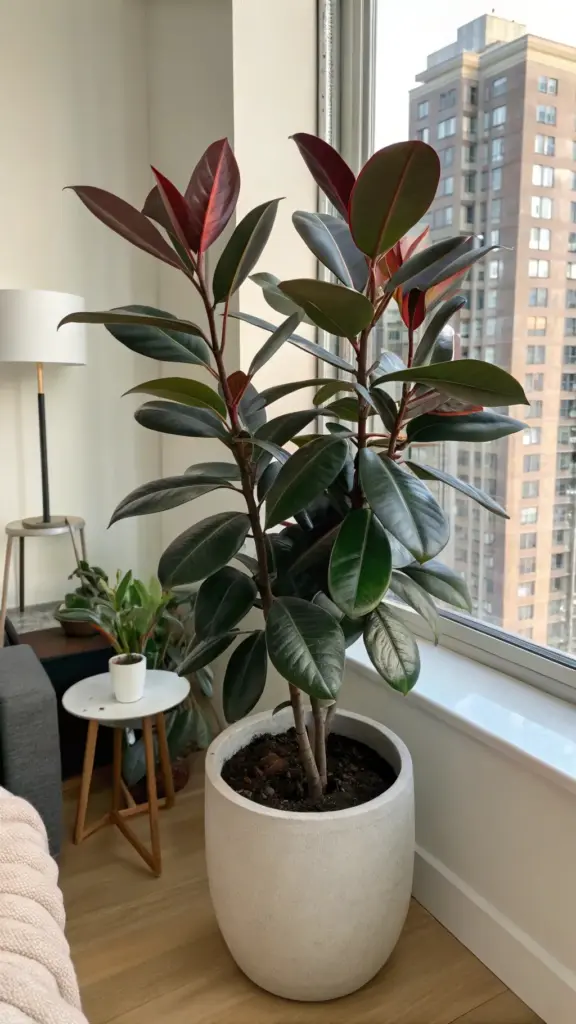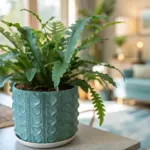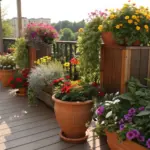5. Ficus elastica ‘Melany’ – The Compact Charmer

When I moved into my tiny Brooklyn apartment, I thought my days of growing impressive rubber plants were over. Then I discovered the ‘Melany’ variety and realized I could have all the drama in half the space.
This little powerhouse has become my go-to recommendation for anyone dealing with space constraints. It’s like having a full-sized rubber plant that someone shrunk down without losing any of the visual impact.
Perfect Dwarf Characteristics for Tight Spaces
The dwarf characteristics of ‘Melany’ are what make it so special for small living situations. This plant maxes out at about 3-4 feet indoors, making it perfect for apartments and condos.
Compact growth habit means it stays bushy rather than growing tall and leggy like regular rubber plants. I can fit mine on a plant stand without worrying about it hitting the ceiling.
The leaf size is proportionally smaller too – about 4-6 inches long compared to the massive leaves on standard elasticas. But don’t let the size fool you – the color intensity is just as dramatic.
Space efficiency is incredible with this variety. I’ve got mine in a corner that wouldn’t accommodate any other rubber plant, and it’s absolutely thriving there.
The branching pattern tends to be more horizontal, creating this gorgeous, full silhouette that works perfectly as a statement piece in smaller rooms.
That Incredible New Growth Transformation
Here’s where ‘Melany’ absolutely blew my mind – the new growth emerges almost black. I’m talking deep, dark burgundy that’s so intense it looks purple in certain lighting.
Deep burgundy new growth unfurls like tiny burgundy scrolls that gradually open over 2-3 weeks. Watching this transformation never gets old – it’s like having a slow-motion fireworks show.
As the leaves mature, they transition from burgundy to deep green with reddish undertones. The color gradient within a single plant creates this incredible depth that photographs beautifully.
Seasonal variations in new growth color are fascinating. Spring growth tends to be more intensely colored than what you see during slower winter months.
I’ve noticed that stress can actually intensify the burgundy coloration. Slight underwatering or cooler temperatures seem to bring out even deeper reds in new leaves.
Container Gardening Success Stories
Container gardening with ‘Melany’ has been surprisingly straightforward compared to larger rubber plant varieties. The smaller root system means less frequent repotting – usually every 2-3 years.
My repotting guidelines have evolved through trial and error. I wait until I see roots coming through drainage holes before moving up to the next pot size.
Pot sizing is crucial – I’ve learned that going too big too fast causes root rot issues. One size up is the golden rule with this variety.
The drainage requirements are the same as larger rubber plants, but the smaller containers dry out faster. I use a chunky potting mix with added perlite for extra drainage.
Root bound tolerance is actually pretty good with ‘Melany’ plants. They seem to like being slightly pot-bound and often produce more colorful growth when roots are snug.
Apartment Living Game-Changer
Apartment living presents unique challenges, but ‘Melany’ handles them like a champ. Low light tolerance is better than most variegated varieties I’ve grown.
Urban gardening applications are endless with this compact size. I’ve seen them thriving on fire escapes, in bathroom windows, and even in darker hallways with supplemental lighting.
The air purification benefits are the same as larger rubber plants, but in a package that actually fits in small spaces. It’s like getting all the benefits without the space commitment.
Neighbor-friendly is another bonus – this plant won’t outgrow its space and become a problem like some of my larger specimens have in previous apartments.
Moving considerations are so much easier with a compact plant. I’ve relocated this beauty three times without the drama of trying to transport a 6-foot tree.
City Climate Survival Tips
Seasonal care adjustments for city climates have been essential for keeping my ‘Melany’ happy year-round. Urban heat islands affect indoor plants more than people realize.
Winter heating systems in apartments can be brutal on houseplants. I move mine away from radiators and use a humidifier to combat the dry air.
Summer air conditioning creates its own challenges. The constant temperature fluctuations can stress the plant, so I try to keep it in a more stable microclimate.
Air quality issues in cities seem to affect this variety less than others. The waxy leaves shed dust easily with regular wiping, which helps with photosynthesis.
Limited natural light in urban settings means I rely heavily on grow lights during winter months. A small LED positioned 12 inches away keeps the colors vibrant when natural light is scarce.
Pollution tolerance has been surprisingly good. I clean the leaves weekly with a damp cloth to remove city grime, and the plant just keeps on thriving.
Want to see a variety that’s so dark it’s almost gothic? Click next to discover the Ficus elastica ‘Abidjan’ – a dramatic beauty with nearly black foliage that creates the most stunning contrast in any room!









GIPHY App Key not set. Please check settings